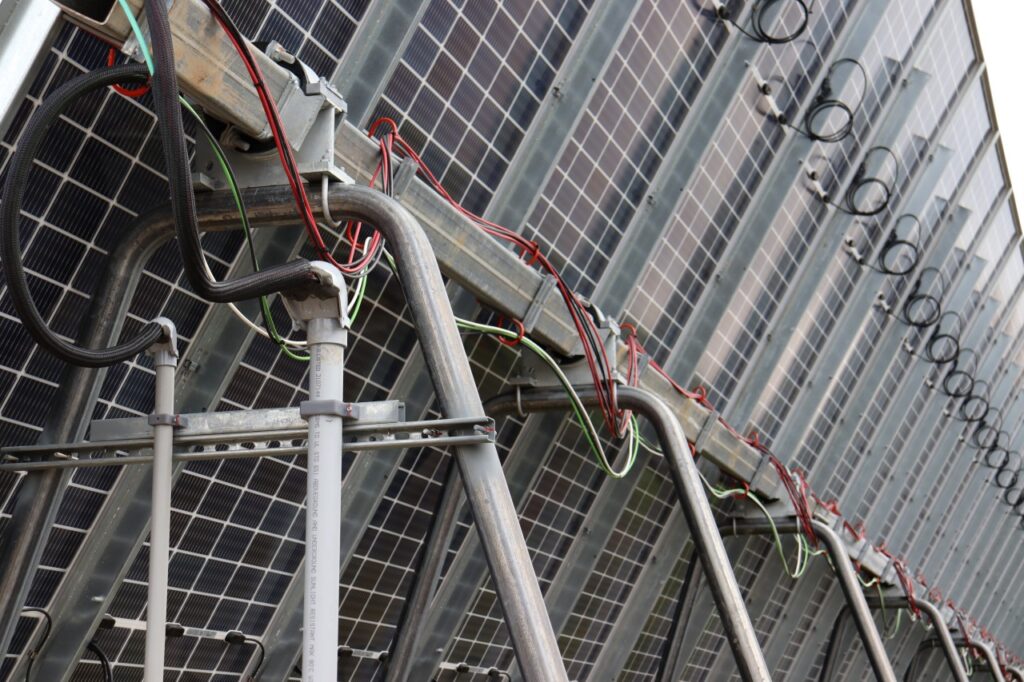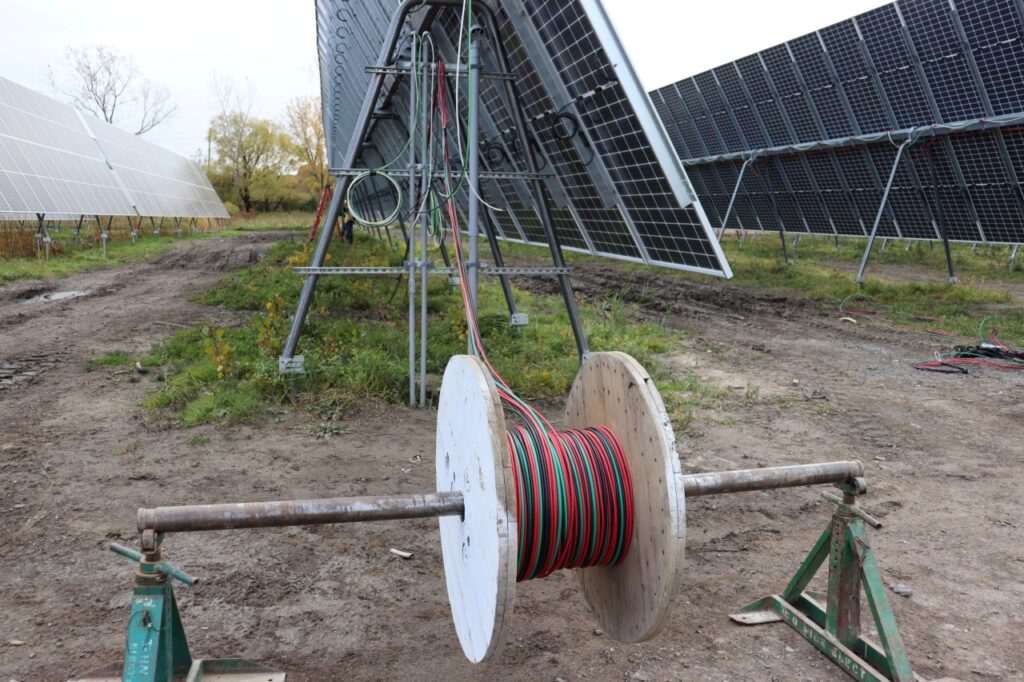Stronger Bottom Lines: Reducing Utility-Scale Solar Installation Costs

If we could sum up the solar industry in 2025, it might sound like the French electronic duo Daft Punk.
“Work it harder, make it better, do it faster, makes us stronger.”
As the solar industry adjusts to a rapidly changing political and economic environment, protecting the bottom line is crucial. Solar developers and EPCs are looking for every advantage possible to keep costs down, including:
- Performing installations faster
- Finding stronger, more reliable solar panels
- Investing in cost-effective racking systems
- Using pre-fabricated modules and factory-made PV wire
- Implementing automated systems to control labor expenses
With the right combination of cost-cutting measures, utility-scale solar developers can reduce costs, maximize labor, and improve project longevity and reliability.
Automation Enhancements
No matter how you might personally feel about AI, robots might not be a bad thing, especially for an industry dealing with labor shortages. When used effectively, automation technology augments workers’ skills, making installations faster and, ultimately, less expensive.
But how exactly do automated systems accomplish that goal?
It all comes down to minimizing the impact of repetitive tasks for workers. Companies like Charge Robotics are taking the lead, creating fully autonomous bots like its Sunrise construction system. The robot quickly assembles and installs solar bays on-site while also performing quality control checks.
For solar developers, the extra set of metal hands goes a long way. Robotic systems reduce jobsite risk and improve overall quality and speed with fewer workers. But Charge Robotics isn’t the only name in the game–it’s one of several start-ups planning to change the solar industry overnight.
AES’s Maximo installs solar panels onto trackers using artificial intelligence (AI). The robotic system is technology agnostic and easily adapts to work with a variety of clamps, trackers, and panels.
Beyond being an installation bot, Maximo takes on other incredibly important tasks on the project site. As it works, the system collects data, keeping solar developers informed about site progress and potential concerns.
It also handles dangerous tasks formerly carried out by crew members. Instead of having a worker install panels onto trackers high above the ground, Maximo does it. Workers safely guide the robot from the ground, allowing it to work without putting crews at risk of falling.
AES’s invention is already making waves, earning support from Amazon. The online retailer has used Maximo for several solar + storage sites that the company has invested in.
The Need for Speed (and Safety)
Regardless of the system, the goal is always the same: speed, safety, and simplicity.
Robots move faster than people, can lift heavy panels by themselves, and place them with pinpoint precision. They also have a keen eye, powered by machine learning, to constantly perform quality control throughout the project.
But, despite their skills and strength, robots and automated systems aren’t here to displace their human counterparts. If anything, they augment our strengths and help us do more with fewer resources.
Robots don’t complain about performing repetitive tasks and can do those jobs faster than a crew of people. In the meantime, workers can focus on big-picture problems to keep projects moving smoothly and fix issues. Machines also alleviate hiring problems that solar developers face, especially in harsh desert environments where it’s tougher to attract quality talent.
Piecing Together Projects
Despite slightly higher upfront costs, factory-made components and modular systems can drastically reduce labor costs and installation times.
The solar industry is facing incredible challenges, forcing EPCs and developers to find creative solutions to do more with less. For companies with tight deadlines, higher initial costs are worth potential long-term savings.
Today’s solar projects are easy to assemble on site, coming together like giant building blocks. From start to finish, pre-built, factory-made parts simplify production and turbocharge development.
Foundations
Foundations are crucial to any solar project. These systems hold racking steady and protect installations from shifting and corrosion caused by severe weather and the environment.
Depending on the site’s location, solar builders have a wide range of concrete ballast options. Manufacturers create the foundations off-site, then truck them in, saving crews precious time.
But why should crews consider a factory-made concrete ballast when they can simply pour foundations? When workers pour concrete out in the field, they run the risk of weather, debris, and even the site itself causing issues. If the concrete doesn’t cure correctly, it won’t be as strong, reducing long-term reliability.
By purchasing pre-made concrete ballasts, weather isn’t a factor since crews don’t need to wait for curing. The result is a plug-and-play building component ready for decades of operation.
Racking and Frames
Solar panel racking supports the panels themselves and, in some cases, tracks the sun as it moves through the sky. They attach directly to the foundation and serve as a skeleton holding everything together.
To hasten construction projects, developers can order pre-drilled racking systems with the hardware already attached. Other times, the racks and frames may also include pre-installed DC wiring. With most of the work already done, crews only need to attach the panels and tighten the bolts.
Wiring and Connectors

If racking is the skeleton, then PV wire and connectors are the blood vessels and nerves. They transport solar energy collected by the panels and carry it to the combiner box as DC electricity.
Years ago, workers would have to carry individual strings of PV wire down long aisles of panels to connect everything. Today, manufacturers like Sun-Pull offer customized PV wire bundles on single spools, cutting installation times and labor costs.
Pre-bundled PV wire gives solar developers the option to do more with less. For example, what used to take a crew of workers a day to complete now only needs a couple of hours with 2-4 people. Sure, bundled wire costs more, but it makes up for the higher price with faster project speed and better resource allocation.
Meanwhile, workers use connectors attached to the ends of PV wire to safely and tightly connect the wiring to the panels. Depending on the project and timeline, manufacturers like Sun-Pull can attach factory-made connectors to the PV wire. While it isn’t an exciting feature, it guarantees that one type of connector is used throughout the site. If crews accidentally use multiple connector types, the risk of poor or loose attachments spikes, potentially creating performance and fire risks.
Pre-fabricated connectors also eliminate potential failure points in the field. Workers have varying levels of job experience, and installation quality varies from one worker to the next. If the connection isn’t tight or if an uncaught mishap occurs, it could lead to arcs, sparks, or system faults.
Manufacturers quality control every product leaving the facility, giving solar EPCs peace of mind on the jobsite. This level of control in the process guarantees the connectors will work as intended for years to come.
Wire Management
From clips and clamps to ties and straps, utility-scale PV projects have no shortage of wire management options.
At their core, management systems protect PV wires from potential dangers, including accidental contact, severe weather, and environmental hazards. Depending on the environment, budget, and application, project managers have a bevy of shapes, sizes, and materials available. This allows developers to choose what works best for them, from simple cable ties and S-clips to more complex conduit trays.
DC Combiner Box
Combiner boxes are as unique as the solar site itself. To that end, manufacturers can design and build boxes for every specific need.
The process for that is straightforward but requires pre-planning. Customers must have exact specifications for what they need, which the manufacturer uses to build the box. This includes installing surge protectors, fuses, and terminated wire harnesses to safely collect and combine electricity.
After strict quality testing, the manufacturer ships the combiner box directly to the jobsite for installation.
Protecting the Bottom Line
Finding cost savings on community- and utility-scale solar projects helps developers save money far beyond their current projects.
Of course, it’s also safe to say that not every project will benefit from the same solutions. Every location has unique opportunities and challenges impacting available options.
Modular systems and automated processes hold several advantages over traditional construction industry methods. Robots installing pre-made parts move much faster than a crew of workers, with the added benefit of checking their work along the way. This frees crew members to focus on other parts of the project that may need additional attention.
Pre-made parts reduce the impact of weather during construction and make sites safer. In a factory setting, manufacturers control production in a stable, consistent environment. Once workers test the components, they can connect them like a huge set of building blocks.
Higher Quality, Less Hassle
In manufacturing facilities, quality is critical.
Factories can QC and QA all components before they leave the factory, reducing the threat of poor installation. This is especially true for PV wire, connectors, and other sensitive equipment, where inexperience could hurt quality.
More importantly, manufacturers are masters of high-level precision. They have the technology and resources to ensure everything fits, works, and performs as it should. By investing in prefabricated materials, crews only worry about installation.
As a result, solar projects require fewer highly experienced workers to oversee everything, easing labor issues.
Scaling Up
When everything is modularized, it’s easy to scale up or down based on what parts you need.
Standardization creates scalability, thanks to more accurate inventory tracking, maintenance procedures, and product acclimation for workers. As the team becomes more familiar with each piece of the puzzle and its processes, they move more confidently. The added speed means shorter timelines, more projects, and healthier bottom lines.
Standard pieces and processes also affect cost structuring, as similar designs and situations may need similar inventories. Over time, familiarity leads to stronger forecasting and budgeting for future projects.
Bottom Line Breakthroughs
Solar projects aren’t cheap, but it’s possible to find cost savings and other bottom-line improvements.
The industry has no shortage of innovative technologies hitting the market every year. For savvy solar developers, understanding the industry, building relationships, and staying on the cutting edge go a long way.
For those builders, it means investing in automated solutions that reduce labor costs and improve safety. It also means reducing material costs through better planning and scalability without cutting corners.
Solar development isn’t slowing down, even as the industry adjusts to rapid change. Those embracing the world around them will have an incredible leg up on the competition.


